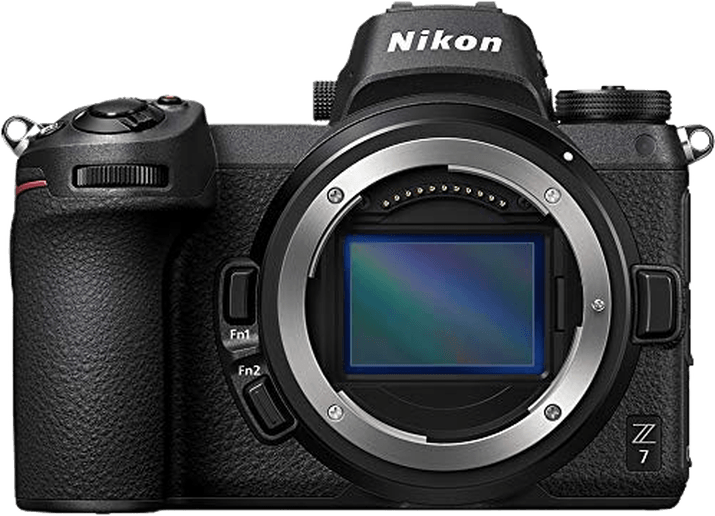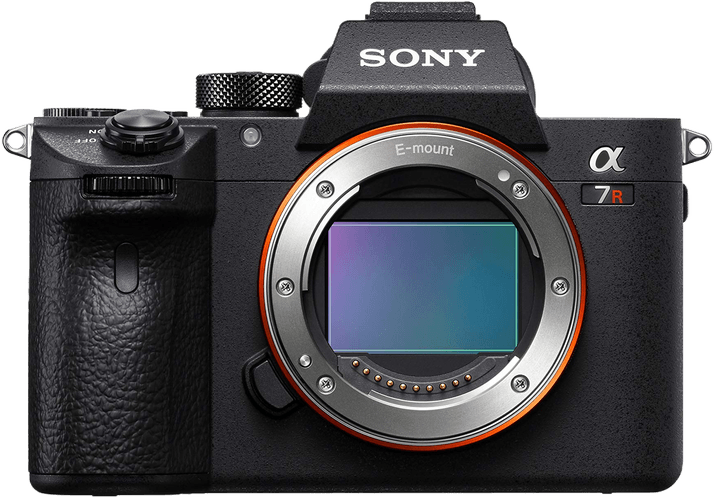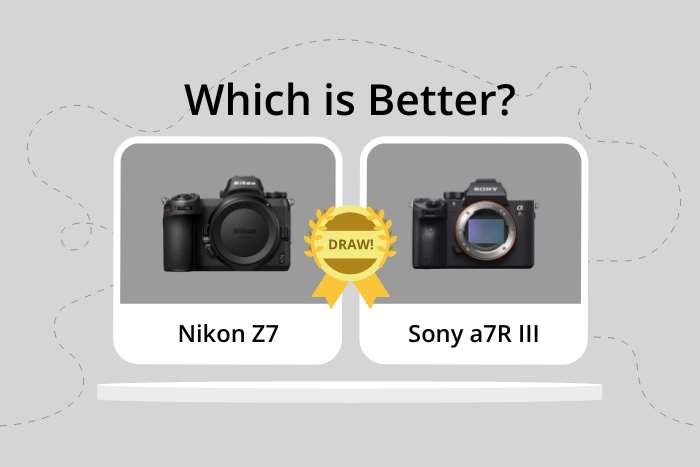Nikon Z7 vs Sony a7R III Comparison
Nikon Z7

Sony a7R III

The Sony a7R III edges out the Nikon Z7 by just one point, with scores of 83/100 and 82/100, respectively. Both cameras are mirrorless and were released within a year of each other. They share similar dimensions, with the Sony a7R III being slightly smaller and lighter at 127 x 96 x 74mm and 657g, compared to the Nikon Z7’s 134 x 101 x 68mm and 675g.
The Sony a7R III holds an advantage with its lower launch price of $3200, while the Nikon Z7 was introduced at $3400. However, the Nikon Z7 is a newer model, having been announced in August 2018, compared to the Sony a7R III’s October 2017 release.
Despite their close scores, the Sony a7R III offers better value with a lower price and slightly smaller size. The Nikon Z7, on the other hand, provides newer technology, but at a higher cost.
Nikon Z7 vs Sony a7R III Overview and Optics
The Nikon Z7 emerges as the winner in optics, scoring 86/100, while the Sony a7R III trails closely with a score of 84/100. Both cameras share several specifications, including a CMOS sensor, full-frame sensor size, and image stabilization. They also have their respective lens mounts – Nikon Z for the Z7 and Sony FE for the a7R III.
The Nikon Z7 holds an advantage with its higher megapixel count of 45.7 compared to the Sony a7R III’s 42.4 megapixels. This difference allows the Z7 to capture more detail and produce higher resolution images. Additionally, the Z7’s Expeed 6 processor outperforms the a7R III’s Bionz X processor, contributing to faster processing speeds and better overall performance.
On the other hand, the Sony a7R III has a slightly faster shooting speed of 10 frames per second (fps) compared to the Nikon Z7’s 9 fps. This difference may be beneficial for photographers who require faster continuous shooting for action or sports photography. Furthermore, the a7R III has a marginally higher DXOMARK score of 100 for its sensor, as opposed to the Z7’s score of 99, indicating a slightly better sensor performance.
Taking these factors into consideration, the Nikon Z7 stands out as the better camera in terms of optics due to its higher megapixel count and superior processor. However, the Sony a7R III remains a strong competitor, offering faster shooting speeds and a marginally higher sensor score. Ultimately, the choice between these two cameras will depend on the specific needs and preferences of the photographer.
Nikon Z7 vs Sony a7R III Video Performance
The Nikon Z7 outperforms the Sony a7R III in video capabilities, scoring 83 out of 100 compared to the Sony a7R III’s score of 56. Both cameras offer 4K video resolution with maximum dimensions of 3840 x 2160, ensuring high-quality video output. However, the Nikon Z7 excels in other aspects of video performance.
The Nikon Z7 has a maximum video frame rate of 60fps, double the Sony a7R III’s 30fps. This higher frame rate enables smoother motion capture and more flexibility in post-production editing, such as creating slow-motion effects. Additionally, the Nikon Z7 includes built-in time-lapse functionality, allowing for easy creation of time-lapse videos without the need for external accessories or software.
While the Sony a7R III has a lower video score, it still delivers 4K video resolution with the same maximum dimensions as the Nikon Z7. This means that the Sony a7R III is still capable of producing high-quality video content, despite its lower frame rate and lack of built-in time-lapse functionality.
Comparing the video capabilities of these two cameras, the Nikon Z7 proves to be the superior choice due to its higher frame rate and built-in time-lapse feature. The Sony a7R III, although not as advanced in video performance, remains a viable option for those prioritizing 4K video resolution. Ultimately, the Nikon Z7’s enhanced video features make it the better choice for videographers seeking more versatile and creative options.
Nikon Z7 vs Sony a7R III Features and Benefits
The Nikon Z7 outperforms the Sony a7R III in features with a score of 87/100, compared to the Sony’s 83/100. Both cameras share several common specifications, including a touchscreen, flip screen, WiFi, and Bluetooth connectivity. Neither camera offers GPS functionality.
The Nikon Z7 excels with a larger 3.2-inch screen, compared to the Sony a7R III’s 3-inch screen. Additionally, the Z7 boasts a higher screen resolution of 2,100,000 dots, while the a7R III has a 1,440,000-dot resolution. This difference in screen size and resolution provides the Z7 users with a clearer and more detailed display for composing and reviewing images.
On the other hand, the Sony a7R III does not have any notable advantages over the Nikon Z7 in terms of features. Both cameras are on par with each other in their shared specifications. The slightly lower feature score of the a7R III is mainly due to its smaller screen size and lower screen resolution.
Taking these factors into account, the Nikon Z7 stands out as the better option for photographers who prioritize a larger and higher-resolution screen. The Sony a7R III, while still a strong contender, does not offer any unique advantages in features over the Nikon Z7. Considering their shared specifications and the Z7’s superior screen, potential buyers may find the Nikon Z7 to be the more appealing choice.
Nikon Z7 vs Sony a7R III Storage and Battery
The Sony a7R III outperforms the Nikon Z7 in storage and battery with a score of 65/100 compared to the Z7’s 35/100. Both cameras share the feature of USB charging, but the similarities end there.
The a7R III has two memory card slots, accepting SD, SDHC, and SDXC cards with UHS-II compatibility, offering more storage options and flexibility. Additionally, its battery life of 650 shots is nearly double that of the Z7, which only provides 330 shots per charge. The a7R III uses an NP-FZ100 battery, contributing to its longer battery life.
On the other hand, the Nikon Z7 has a single memory card slot, supporting only XQD cards. Its battery, the EN-EL15b, provides a shorter battery life compared to the a7R III. However, the Z7 does have the advantage of USB charging, which the a7R III lacks.
Considering these points, the Sony a7R III is the clear winner in storage and battery capabilities, offering greater convenience and flexibility for users. The Nikon Z7 falls short in this category, but its USB charging capability is a small consolation.
Nikon Z7 vs Sony a7R III Alternatives
Still not sure which camera to go for? You can check out these trending camera comparisons for inspiration:

